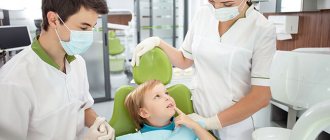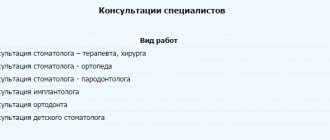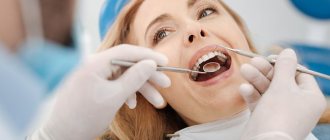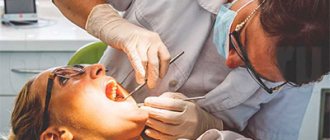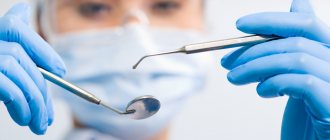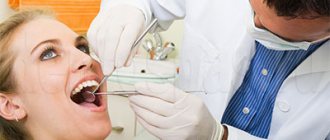| [organizational and legal form, name of organization, enterprise] | I approve [position, signature, full name of the manager or other official authorized to approve the job description] [day month Year] M.P. |
Job Description for Dental Assistant
This job description has been developed and approved in accordance with the provisions of the Labor Code of the Russian Federation and other regulations governing labor relations.
What is a Dental Assistant?
A dental assistant is the same person who meets and greets the patient, invites him to enter the office, offers to make himself more comfortable in the chair, and tells him where to put things away.
First of all, of course, he is an assistant to the attending physician. He provides the necessary tools and cooperates with the doctor during the entire work process.
But his role is also to create the most comfortable conditions for the patient. It is thanks to the assistant’s friendly smile, his care and attention that many people lose their fear of the upcoming procedure.
An attentive employee will always notice what the patient needs at the moment - adjust the chair, rinse his mouth.
Before the appointment, the assistant will definitely tidy up the workplace, seat the patient in a chair with all the amenities, adjust the light and prepare the instruments.
You can ask your doctor’s assistant any questions you have about treatment - he will explain everything: from the specifics of concluding a contract for the provision of dental services to a detailed explanation of each step of the operation.
You can get advice from him about caring for your teeth and oral cavity, about different types of fillings, he can recommend toothpaste and a brush - in short, everything related to dental issues and treatment itself, the assistant will tell and explain to the patient in detail.
And if there is a child at a dental appointment, the assistant will do everything to calm and entertain the little patient.
The patient discusses the date of the next appointment with the dentist's assistant - he will call in advance and remind the person about the appointment.
An assistant is a significant figure not only for the doctor, but also for the patient.
Training course for dental assistants on video:
Wage
The work of a dental assistant is assessed quite well. The highest salaries in this industry are, of course, noted in Moscow. In large dental clinics, assistants are paid from 60-75 thousand rubles per month, while those who work in smaller offices have to be content with 25-30 thousand rubles. There are a lot of open vacancies on labor exchanges, so a dental assistant can find a good job quite quickly. In the regions, things are not so rosy - there are much fewer places there, and salaries are an order of magnitude lower. The average level is 20-25 thousand, while some clinic assistants are willing to pay no more than 15 thousand rubles per month.
Key Knowledge
The assistant must have basic skills in medicine, as well as be a professional in his field. The young specialist has a secondary medical education (college, technical school, school) with a specialty in nursing.
Periodically, the employee undergoes certification to confirm his knowledge.
This is what the qualification requirements look like in an employment contract for a medical worker of this profile:
| Conditions for tenure | Requirements |
| Education | Specialized secondary |
| Speciality | Nursing |
| Work experience by profession | From 1 year |
| Professional recertification | Once every 6 months |
Since the assistant, in addition to assisting the doctor, also resolves controversial issues with visitors and keeps a journal, his knowledge is not limited to narrow-profile ones.
Here is a complete list of what the assistant should know:
- laws regulating the activities of healthcare institutions and other norms and acts relating to order in this area;
- labor Code;
- how to organize medical dental care at a basic level;
- structure and functions of the jaw and teeth;
- biological mechanics of the masticatory apparatus;
- theory of treatment of the most common orthopedic pathologies;
- how to organize preventive medical dental care for children and adults;
- about methods of preventing dental diseases;
- about how to properly care for the oral cavity;
- rules for sanitary treatment of dental premises;
- methods of providing emergency medical care;
- safety precautions;
- basic principles of working with a computer and documentation (PC operator);
- rules of etiquette.
As you can see, a junior employee needs to know quite a lot.
Disinfection of gloves
The assistant disinfects:
- your gloves and the doctor’s gloves before starting the treatment;
- the doctor's gloves every time during the appointment, after he touched the lamp, chair, medical card, picture and other objects.
The procedure for disinfecting gloves in the patient’s field of view:
- the doctor presents his gloved hands folded in the shape of a boat,
- the assistant treats the doctor’s gloves with a disinfectant spray,
- the assistant processes his gloves.
Typical shortcomings and errors in the aspect of “Disinfection of gloves”
Assistant:
- disinfects gloves out of sight of the patient;
- disinfects gloves by spraying the spray on the patient’s face;
- delays in processing gloves, forcing the doctor to disinfect his gloves himself.
Doctor:
- without waiting for an assistant, he disinfects his gloves himself;
- presents an outstretched arm with a vertically raised palm for processing;
- based on the patient, does not ask the assistant to disinfect gloves after touching anything;
- touching something, disinfects gloves out of sight of the patient or without voicing this action to the patient.
Job responsibilities
What is the main job of the employee:
- Preparing the office for receiving clients and for the work process. First, the worker wet cleans the room using disinfectant cleaning agents and ventilates the space. According to the schedule, it carries out antimicrobial and antiviral air treatment using a quartz lamp.
- Preparation of the necessary tools and materials that will be involved in the work process. The employee must sterilize reusable instruments and ensure that disposable ones are in suitable condition. If necessary, make blanks of working material - for example, an impression for crowns.
- Preparation of medicines.
- Providing dressings and auxiliary materials - cotton swabs, napkins, bandages, gauze, napkins.
- Assisting the doctor during medical procedures, accurately following the doctor’s instructions.
- Administration of anesthesia to the patient.
- Ensuring client comfort.
- Caring for the patient - the assistant must promptly offer a glass of rinsing and ensure that there are no medication residues on the face and clothes.
- Maintaining records in reception and control logs, maintaining documentation, filling out paper documents.
- At the end of the working day, the dental assistant performs the same procedures as in the morning - cleaning the room, sterilizing instruments.
A dental assistant is a responsible position. It is the junior employee who is responsible for the safety and cleanliness of tools and the serviceability of equipment. If an employee discovers any malfunction of equipment or a breakdown of an instrument, he informs the doctor and the administration of the institution about this and makes a note about it.
The assistant ensures that all necessary medications and materials are available and in sufficient quantity, and keeps a constant record of these funds.
Informing the visitor is also his responsibility. The employee must notify the patient about the side effects of the medications used and warn about possible pain.
The assistant is responsible for the accuracy and reliability of all production records and for the safety of documentation.
The junior employee is rightly called the “right hand” of the dentist.
Dental assistant job description can be found here.
Records management
The second component of the responsibilities of a dental assistant is maintaining reporting and current documentation. The assistant fills out patient charts (in paper or electronic form) and keeps various logs:
- on safety precautions;
- medication accounting;
- cleaning;
- disinfection and sterilization;
- equipment serviceability.
Entries in these documents must be made in a timely manner; patient cards are filled out immediately - at the appointment.
Additional Responsibilities
However, the job description does not end there. The assistant also has secondary responsibilities.
They include:
- General cleaning of the office once a week - including washing the walls and ceiling.
- Window cleaning according to schedule.
- Meeting the patient at the reception desk and accompanying him to the office.
- Attendance at meetings, conferences, and official events.
- Providing emergency medical care to the patient if required.
The dental assistant, like other clinic employees, participates in the discussion of work issues, makes suggestions for improving the activities of the institution and the provision of services, and makes comments.
The doctor and assistant actively cooperate, jointly conduct the process of medical care, and consult. The doctor and assistant act together harmoniously - like a single organism.
Assistant training process on video:
4-hand operation
In advertisements for dental assistant searches, the authors tend to often indicate that the candidate must have sufficient skills and qualifications to work with a doctor four-handed. What does this mean? The doctor is forced to perform all dental procedures quite quickly: many filling materials, as well as medications, must be removed from the packaging as soon as possible and used for their intended purpose. At the same time, it is important to follow the stages of work, not to confuse anything. Sometimes the work requires illuminating the area of dental reconstruction with a special lamp, which the doctor himself cannot do. Also, the doctor often needs a quick change of working tools, attachments on drills, mirrors, and forceps. It is to quickly perform all these tasks that a dental assistant is required. The assistant’s responsibilities are to always be within the doctor’s reach, quickly respond to his requests and know the sequence of his main actions in order to be able to predict the boss’s “order.”
If the tandem is successful, and the doctor and his assistant understand each other perfectly, then their productivity increases significantly. That’s why clinics encourage working with 4 hands. The duties of a dental assistant do not require a person to show excessive initiative; on the contrary, it is important that the assistant maintain business and personal subordination with the doctor, be diligent, attentive and responsible.
Work schedule
The job responsibilities of a dental assistant can be roughly divided into two components. The first is precisely the workflow and its interaction with the doctor. In addition, the dental assistant must have time to put the office in order, order medications, instruments, consumables on time, disinfect and sterilize instruments. Fulfilling these duties cannot be at the expense of providing assistance to the physician when required.
An assistant, as a rule, comes to work before the doctor and leaves later than him - in order to have time to prepare the workplace before seeing patients and to always be in the doctor's support. Dentists usually work in shifts - before or after lunch. Assistants are also not in the clinic from dawn to dusk; their working day depends on the doctor’s schedule, but it is longer than that of their immediate superior.
Supply of tools and materials
The assistant gives the doctor: a carpule syringe with anesthetic, instruments, materials that are needed at this stage of treatment, a machine tip with a bur.
Rules for administering anesthetic:
- the assistant hands over the carpule syringe, clearly naming the anesthetic,
- the doctor intercepts the syringe,
- the assistant removes the protective cap from the needle,
- both partners verbally and non-verbally relax the patient.
Ten rules for filing instruments
- Never pass instruments over the patient's head or face.
- The assistant passes the instrument over the patient's chest so that he does not experience discomfort.
- In the case of transferring a surgical instrument (for example, forceps for tooth extraction), it is allowed to transfer it behind the patient's head.
- Always hand the instrument to the doctor with the working end towards the tooth being prepared so that the handle of the instrument is in the closest and most convenient position for gripping to the doctor’s leading hand.
- Handle sharp instruments or instruments with two handles (forceps, scissors) carefully to avoid injury to the patient or doctor.
- Avoid collision of the assistant's hands with the doctor's hands.
- The required instrument must be placed in the hands of the doctor in such a way as to ensure interception and prevent the instrument from falling.
- The instrument must be given and received in such a way that the doctor’s hand makes as little movement as possible.
- Do not pick up the instrument if it has fallen to the floor.
- If the instrument falls on the floor, then you should note to the patient that you will replace the instrument with a sterile one. Otherwise, the patient may view the instrument falling as a situation that prevents treatment from continuing properly.
Note. When the assistant puts the protective cap on the carpule needle after injecting the anesthetic, he needs to be as careful as possible and not rush, so as not to injure himself - a needle prick. Please remember that the needle can become infected.
Responsibility
The dental assistant is responsible for:
4.1. For non-fulfillment or improper fulfillment of the duties provided for in these instructions - within the limits determined by the labor legislation of the Russian Federation.
4.2. For offenses committed in the course of carrying out their activities - within the limits determined by the current administrative, criminal and civil legislation of the Russian Federation.
4.3. For causing material damage to the employer - within the limits determined by the current labor and civil legislation of the Russian Federation.
The job description has been developed in accordance with [name, number and date of document].
Light adjustment
Assistant:
- directs the light of the lamp so that it directly illuminates the area in the patient’s oral cavity required for examination or treatment;
- sets the lighting differently for each jaw: when working on the lower jaw, the light is directed straight down; when working on the upper jaw, the light should be directed at an angle;
- makes sure that the light does not shine in the patient’s eyes;
- promptly turns on, turns off and adjusts the brightness of the lamp depending on the stage of treatment (for example, when selecting burs or working with light-curing materials, the lamp light should be dimmed).
Notes:
- the assistant should be able to reorient or turn off the lamp at any time, so it should be at a distance no further than his outstretched arm;
- The assistant turns off the lamp light in the following cases:
- every time a doctor talks with a patient, discussing a treatment plan (prosthetics), giving recommendations, making a prognosis;
- when determining the color of a future restoration or prosthesis, when natural lighting is needed.
Typical shortcomings and errors in the “Light adjustment” aspect
Assistant:
- incorrectly sets the light of the installation lamp - the area of the surgical field is not illuminated or is not illuminated enough;
- does not dim the brightness of the lamp when working with light-curing materials in the patient’s oral cavity;
- does not turn off the lamp light when it is possible to give the patient a rest (for example, when changing the bur).
Doctor:
- adjusts the light of the lamp independently, not trusting the assistant to do this or anticipating his actions when he is slow.
